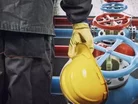The upside of BLOWDOWN

Effective plant safety designs and operations
Greater accuracy saves time and money. Achieving greater safety saves lives. When engineers equip themselves with the right tools that elevate their safety expertise, they can conduct rigorous and rapid depressurisation studies quickly, cost effectively and safely. With cutting-edge blowdown software, detailed analysis and protection of key process equipment can be performed more effectively.
Economically optimised designs are increasingly important to engineering projects today. When it comes to depressurisation systems, piping costs typically consume a significant portion of project expenses, making it imperative to design systems that ensure safety and also minimise unnecessary costs associated with this piping. Piping costs can increase during depressurisation analysis when low temperature regions result, ultimately requiring more expensive materials of construction in these regions. Assessing the specific regions where low temperatures form, and subsequently the adequacy of materials, can be difficult and vague with traditional methods. However, with the right tools, performing the most accurate minimum design metal temperature (MDMT) analysis saves costs while ensuring materials of construction used in the system will not fracture. Determining the certainty of values is imperative to avoid unnecessary expenses and preclude the risk of over-conservative specifications. For a comprehensive end-to-end depressurisation solution, robust blowdown simulation software provides oil and gas companies with the best tools available to help every process engineering project, ranging from new build facilities to a revamp project on an existing process and design or rate blowdown systems that ultimately ensure proper safety.
Managing pressure
For engineers, there are important considerations for determining a safe system, including accurate orifice sizing, metallurgy selection and the ability to integrate with the flare system. A side-effect of depressurisation is the drastic temperature reduction in plant equipment and associated piping. This temperature effect must be determined accurately to identify suitable materials of construction. An example of increasing safety is the gas pressure inside a vessel, which needs to be reduced to minimise damage or a fire.
Making the best engineering decisions requires the ability to accurately predict the minimum metal temperature of equipment and orifice size required in a system. Factors involving the modelling of temperatures, pressures and maximum flow rates during the blowdown process will reduce overdesigns associated with the blowdown system and save enormous engineering costs. Accurately depressuring the system minimises the risk of harm to the process equipment, product and personnel.
Therefore, effective safety analysis is vital to process design and with powerful simulations tools it is possible to create concurrent designs with simulation, which minimises reworks enabling engineers to reuse and refine safety analysis at each stage of the design lifecycle. By reducing conservative assumptions, the engineer will also reduce capital expenditure. In addition, they have complete control to push assets to the limit to maximise throughput, troubleshoot efficiently with confidence and more accuracy whilst conducting safety analysis. Essentially, engineers can now evaluate systems, safer and faster much easier within ONE engineering environment.
Safety standards
Blowdown is a critical rapid response system. It is crucial to ensure that this analysis determines not only safe materials of construction, but also provides the correct orifice sizes that depressure systems in accordance with leading industry standards, such as API and NORSOCK for fire cases. This action reduces the incidents that cause irrevocable damage. Using a flare system analyser as a part of your blowdown analysis is also essential to ensuring your entire depressurisation analysis is safe from the blowdown system through the discharge of the flare header.
Better safety decisions deliver better outcomes. Being able to rapidly evaluate the safest and most profitable designs adds value and ensures improved engineering productivity, investment costs and increases overall engineering efficiency. With the world’s most powerful and comprehensive process modelling tool, oil and gas projects are made less complex whilst enabling engineers to save time and ensure process models optimise conceptual design and plant operations.
Simulation with enhanced safety functionality delivers enormous benefits to companies in the process industries. A high fidelity thermodynamic design model means that engineers can be confident that their calculations are robust and fully predictive.
BLOWDOWN is the industry leading technology developed and validated Dr Graham Saville and Professor Stephen Richardson of Imperial College and incorporated into Aspen HYSYS, which is part of AspenTech’s aspenONE Engineering suite. The robust software powered by the BLOWDOWN technology enables engineers to determine orifice sizes and pinpoint areas of low temperature concerns, providing less conservative MDMT values. In some cases, this can lead to cost savings resulting from less expensive materials. BLOWDOWN technology has been used in over 400 projects in oil and gas and chemical companies to model depressurisation. The software identifies specific locations in a system where temperatures can decline dramatically during depressurisation. With these enhanced safety features, engineers can best serve workflows and safety projects easily, as well as perform accurate safety analysis and leverage data from powerful simulators – all within ONE integrated engineering simulation environment.
The upside of accuracy
Improving safety through accurate modelling of depressurisation systems is a critical activity in the design and operation of every process plant. The detailed analysis capability for orifice sizing and determination of appropriate materials of construction helps significantly when evaluating capital costs and ensuring safety. Today, oil and gas companies are standardising on engineering software with robust blowdown functionality that provides the ability to simulate depressurising vessels and other equipment up to the flare tips. The upside is that engineers can take depressurisation analysis to another level in accuracy and leverage blowdown simulation software to minimise overdesign and project CAPEX both in design and revalidation.
Katherine Hird is Product Marketing Specialist at AspenTech
Follow @ManufacturingGL and @NellWalkerMG
- How Manufacturers Can Scale Faster by Looking ExternallyTechnology
- Smurfit Kappa collaborates with artist Oliver Grossetête to produce corrugated boxes into artAI & Automation
- Ball Corporation wins silver and bronze awards for design innovationLean Manufacturing
- What does generative design and AI mean for design thinking?Technology

